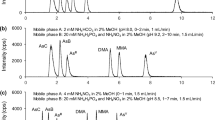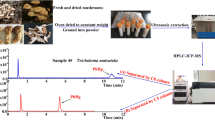Abstract
The content of total arsenic was determined by inductively coupled plasma mass spectrometry after microwave digestion. The results showed that the content of total arsenic was ranged from 0.04 to 212.3 mg kg−1 in the test edible mushrooms. The content of total arsenic in eight test samples was greater than 0.5 mg kg−1. However, the toxicity of arsenic is closely related to the chemical form. Therefore, the determination of arsenobetaine, arsenocholine, dimethylarsinic acid, monomethylarsonic acid, arsenite, and arsenate in edible mushrooms was performed on an ion exchange chromatography column (Dionex IonPac AS19) with inductively coupled plasma mass spectrometry as a detector. When water and 50 mM (NH4)2CO3 (pH = 9.7) were worked as a mobile phase, the six arsenic species could be well separated in 20 min. Ultrapure water was selected as extraction solvent for the validation of ultrasound-assisted extraction method due to its advantage of simple, cheap, and high extraction efficiency. Under optimum conditions, the limits of detection were <2.5 μg kg−1 of the test arsenic species for arsenic, and the recoveries of all six arsenic species were >91.0 % with the relative standard deviation of <5.5 %. The method was applied to 19 different mushroom samples. The results indicated that the total content of arsenic species was basically identical with the content of total arsenic. And arsenobetaine was proved to be the main arsenic species in the test Lentinus edodes-2 sample.







Similar content being viewed by others
References
Brisbin JA, B'Hymer C, Caruso JA (2002) A gradient anion exchange chromatographic method for the speciation of arsenic in lobster tissue extracts. Talanta 58(1):133–145
Brown JL, Kitchin KT, George M (1997) Teratog Carcinog Mutagen, pp 71–84
Byrne AR, Tušek-Žnidarič M (1983) Arsenic accumulation in the mushroom Laccaria amethystina. Chemosphere 12(7):1113–1117
Byrne AR, Šlejkovec Z, Stijve T, Fay L, Gössler W, Gailer J, Irgolic KJ (1995) Arsenobetaine and other arsenic species in mushrooms. Appl Organomet Chem 9(4):305–313
Chen S, Du Z, Liu L, Jiang H (2014) Analysis of arsenic metabolites of realgar in rat viscera by HPLC-ICP-MS. Chinese. J Anal Chem 42(3):349–354
Gast CH, Jansen E, Bierling J, Haanstra L (1988) Heavy metals in mushrooms and their relationship with soil characteristics. Chemosphere 17:789–799
Gonzálvez A, Llorens A, Cervera ML, Armenta S, Guardia MDL (2009) Non-chromatographic speciation of inorganic arsenic in mushrooms by hydride generation atomic fluorescence spectrometry. Food Chem 115(1):360–364
Hindmarsh JT, Mccurdy RF (1986) Clinical and environmental aspects of arsenic toxicity. Crit Rev Clin Lab Sci 23(4):315–347
JECFA (1988) Arsenic (WHO Food Additives Series 24). JECFA Monographs, pp 658
Kalač P (2010) Trace element contents in European species of wild growing edible mushrooms: a review for the period 2000–2009. Food Chem 122(1):2–15
Koch I, Wang LX, Reimer KJ, Cullen WR (2000) Arsenic species in terrestrial fungi and lichens from Yellowknife, NWT, Canada. Appl Organomet Chem 14(5):245–252
Kuehnelt D, Goessler W, Irgolic KJ (1997) Arsenic compounds in terrestrial organisms I: Collybiamaculata, Collybiabutyracea and Amanita muscaria from arsenic smelter sites in Austria. Appl Organomet Chem 11(4):289–296
Larsen EH, Hansen M, Goessler W (1998) Speciation and health risk considerations of arsenic in the edible mushroom Laccaria amethystina collected from contaminated and uncontaminated locations. Appl Organomet Chem 12(4):285–291
Li T, Wang Y, Zhang J, Zhao Y, Liu H (2011) Trace element content of boletus tomentipes mushroom collected from Yunnan, China. Food Chem 127(4):1828–1830
Londesborough S, Mattusch J, Wennrich R (1999) Separation of organic arsenic species by HPLC–ICP-MS. Fresenius J Anal Chem 363:577–581
Mao X, Chen B, Huang C, He M, Hu B (2011) Titania immobilized polypropylene hollow fiber as a disposable coating for stir bar sorptive extraction- liquid chromatography-inductively coupled plasma mass spectrometry speciation of arsenic in chicken tissues. J Chromatogr A 1218(1):1–9
Monasterio RP, Londonio JA, Farias SS, Smichowski P, Wuilloud RG (2011) Organic solvent-free reversed-phase ion-pairing liquid chromatography coupled to atomic fluorescence spectrometry for organoarsenic species determination in several matrices. J Agric Food Chem 59(8):3566–3574
Narukawa T, Inagaki K, Kuroiwa T, Chiba K (2008) The extraction and speciation of arsenic in rice flour by HPLC-ICP-MS. Talanta 77(1):427–432
Nearing MM, Koch I, Reimer KJ (2014) Arsenic speciation in edible mushrooms. Environ Sci Technol 48(24):14203–14210
Nischwitz V, Pergantis SA (2005) Liquid chromatography online with selected reaction monitoring electrospray mass spectrometry for the determination of organoarsenic species in crude extracts of marine reference materials. Anal Chem 77(17):5551–5563
Ouzouni PK, Petridis D, Koller W, Riganakos KA (2009) Nutritional value and metal content of wild edible mushrooms collected from West Macedonia and Epirus, Greece. Food Chem 115(4):1575–1580
Racz L, Papp L, Prokai B, Kovács Z (1996) Trace element determination in cultivated mushrooms: an investigation of manganese, nickel, and cadmium intake in cultivated mushrooms using ICP atomic emission. Microchem J 54(4):444–451
Sanz E, Munoz-Olivas R, Cámara C (2005) Evaluation of a focused sonication probe for arsenic speciation in environmental and biological samples. J Chromatogr A 1097(1):1–8
Schaeffer R, Soeroes C, Ipolyi I, Fodor P, Thomaidis NS (2005) Determination of arsenic species in seafood samples from the Aegean Sea by liquid chromatography-(photo-oxidation)-hydride generation-atomic fluorescence spectrometry. Anal Chim Acta 547(1):109–118
Sesli E, Tuzen M, Soylak M (2008) Evaluation of trace metal contents of some wild edible mushrooms from Black sea region, Turkey. J Hazard Mater 160(2):462–467
Slejkovec Z, Byrne AR, Stijve T, Goessler W, Irgolic KJ (1997) Arsenic compounds in higher fungi. Appl Organomet Chem 11(8):673–682
Slekovec M, Goessler W, Irgolic KJ (1999) Inorganic and organic arsenic compounds in slovenian mushrooms: comparison of arsenic-specific detectors for liquid chromatography. Chem Spec Bioavailab 11(4):115–123
Smith PG, Koch I, Reimer KJ (2007) Arsenic speciation analysis of cultivated white button mushrooms (Agaricus bisporus) using high-performance liquid chromatography-inductively coupled plasma mass spectrometry, and x-ray absorption spectroscopy. Environ Sci Technol 41(20):6947–6954
Soeroes C, Kienzl N, Ipolyi I, Dernovics M, Fodor P, Kuehnelt D (2005) Arsenic uptake and arsenic compounds in cultivated Agaricus bisporus. Food Control 16(5):459–464
Stijve T, Noorloos T, Byrne AR, Slejkovec Z, Goessler W (1998) High selenium levels in edible Albatrellus mushrooms. Deut Lebensm-Rundsch 94(8):275–279
Sun GX, Williams PN, Zhu YG, Deacon C, Carey AM, Raab A, Meharg AA (2009) Survey of arsenic and its speciation in rice products such as breakfast cereals, rice crackers and Japanese rice condiments. Environ Int 35(3):473–475
Tsuda T, Babazono A, Ogawa T, Hamada H, Mino Y, Aoyama H, Inomata S (1992) Inorganic arsenic: a dangerous enigma for mankind. Appl Organomet Chem 6(4):309–322
Turkekul I, Elmastas M, Tüzen M (2004) Determination of iron, copper, manganese, zinc, lead, and cadmium in mushroom samples from Tokat, Turkey. Food Chem 84(3):389–392
Vega L, Styblo M, Patterson R, Cullen W, Wang C, Germolec D (2001) Differential effects of trivalent and pentavalent arsenicals on cell proliferation and cytokine secretion in normal human epidermal keratinocytes. Toxicol Appl Pharmacol 172(3):225–232
Volker N, Pergantis SA (2006) Improved arsenic speciation analysis for extracts of commercially available edible marine algae using HPLC-ES-MS/MS. J Agric Food Chem 54(54):6507–6519
Wang P, Zhao G, Tian J, Su X (2010) High-performance liquid chromatography-inductively coupled plasma mass spectrometry based method for the determination of organic arsenic feed additives and speciation of anionic arsenics in animal feed. J Agric Food Chem 58(9):5263–5270
Whitacre RW, Pearse CS (1972) Mineral Industries Bulletin, Colorado, School of Mines, pp: 1–2
Acknowledgments
The work was financed by Beijing Key Laboratory of Diagnostic and Traceability Technologies for Food Poisoning.
Author information
Authors and Affiliations
Corresponding author
Ethics declarations
Funding
The work was financed by Beijing Key Laboratory of Diagnostic and Traceability Technologies for Food Poisoning.
Conflict of Interest
Shaozhan Chen declares that he has no conflict of interest. Qiaozhen Guo declares that he has no conflict of interest. Liping Liu declares that she has no conflict of interest.
Ethical Approval
This article does not contain any studies with human or animal subjects.
Informed Consent
Not applicable
Rights and permissions
About this article
Cite this article
Chen, S., Guo, Q. & Liu, L. Determination of Arsenic Species in Edible Mushrooms by High-Performance Liquid Chromatography Coupled to Inductively Coupled Plasma Mass Spectrometry. Food Anal. Methods 10, 740–748 (2017). https://doi.org/10.1007/s12161-016-0629-9
Received:
Accepted:
Published:
Issue Date:
DOI: https://doi.org/10.1007/s12161-016-0629-9




